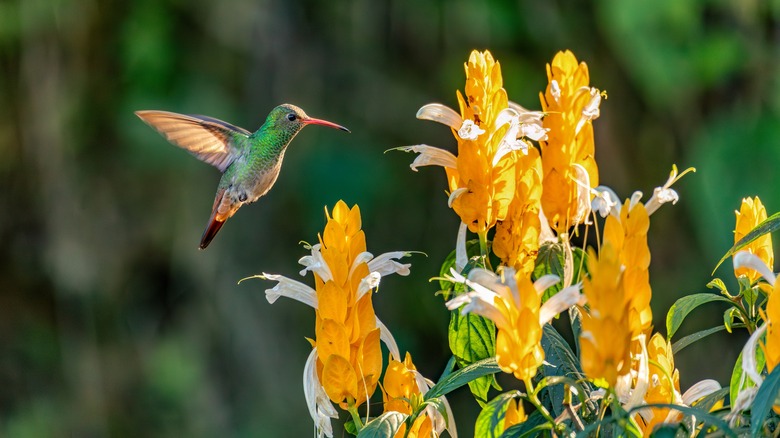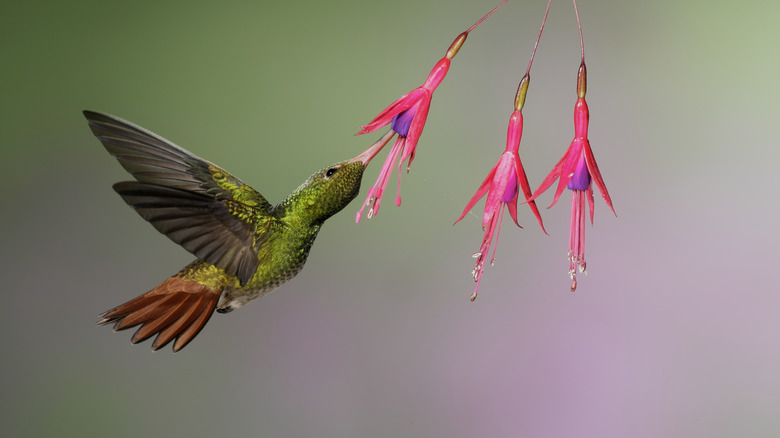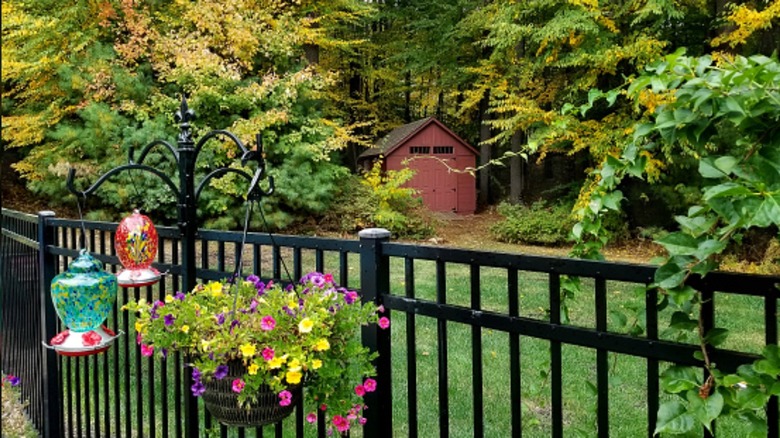The Plant Texture Missing From Your Garden That Will Bring In Hummingbirds
Hummingbirds are among the backyard visitors many homeowners clamor for. These little birds can offer a lot of benefits to your yard while also adding a touch of whimsy at the same time. There are myriad hacks to make a backyard or garden more alluring for hummingbirds, yet, the texture of plants is often left out of the equation. Though it is something that Marlene Pantin, the plants for birds partnerships manager at the National Audubon Society, says should be a crucial thing for people to consider.
One color in particular, red, is what you should add to the garden to help attract hummingbirds. But aside from bold bright colors and aesthetics, hummingbirds love soft-textured plants, according to Pantin. "Plants with a fuzzier texture, like cinnamon fern, pussy willow, thistle, and dandelion, are good for nesting," she told House Digest in an exclusive interview. This plethora of puffy plants gives a whole new meaning to warm and fuzzy, and hummingbirds will love having these options available to them.
Plants are important to hummingbirds
As with any ecosystem, hummingbirds and plants rely on each other. According to expert Marlene Pantin, they coexist for several reasons, the biggest of which are nectar and nesting materials. Speaking exclusively to House Digest, she explained what makes certain plants more irresistible to hummingbirds. "Texture is one important factor when selecting plants that will attract hummingbirds, but so is color and shape," she said.
"For nectar, look for plants that have red, pink, or orange flowers, or a tubular shape," Pantin went on to explain. The lupine, for instance, is a gorgeous plant that is a hummingbird magnet. "Native species are best, not just for the birds but for the larger ecosystem." The National Audubon Society even has a helpful guide on making a hummingbird-friendly yard that includes a list of the best native plants, many of which have variety of textures that hummingbirds love. You should also consider fuzzy native plants like anise hyssop, cardinal flower, and spotted and red bee balm, which hummingbirds love, Pantin added.
Native plants are also known for producing more helpful nectar for hummingbirds than non-native plants. You don't have to have a garden full of these plants to make a difference either. Something as simple as trumpeted flowers in a hanging basket can attract more hummingbirds to your yard.
Choose your plants strategically
When you plant a hummingbird-friendly garden or yard, you can't just cram a bunch of similar plants together. The best solution is to strategically determine which plants will complement the season to keep the hummingbirds coming back. According to Marlene Pantin, who spoke exclusively to House Digest, the key is to go for different bloom times in addition to a variety of textures, colors, sizes, and types of plants.
"It's a good idea to make sure you have plants that don't bloom at the same time, so you can attract hummingbirds for a longer period!" Pantin advised. Other than that, she said it's a good idea to avoid using insecticides. That's because hummingbirds also eat insects and offers up even more food sources for these beloved garden visitors. Differing up your plants by when they bloom and offering tantalizingly textured flower choices is all but guaranteed to bring hummingbirds to your yard.
You can also make your outdoor space even more hummingbird friendly by offering them fresh bird fountains and nectar feeders, Pantin explained. The National Audubon Society even has their own very simple nectar solution for the feeder. All you need is ¼ cup of refined white sugar, a cup of boiling water, a spoon and a bowl. Mix the sugar and water until all the sugar is dissolved and allow to cool. Once it is cooled, fill the feeder and hang it.


